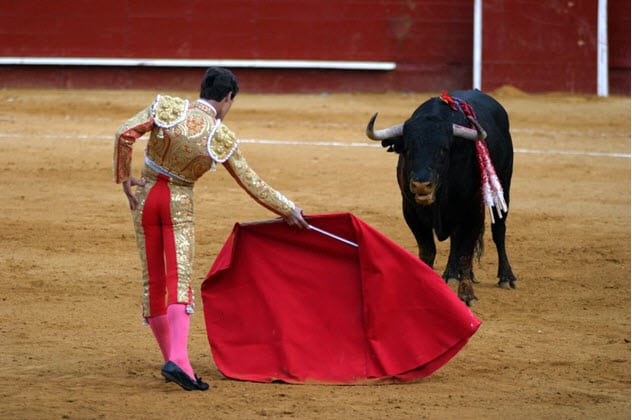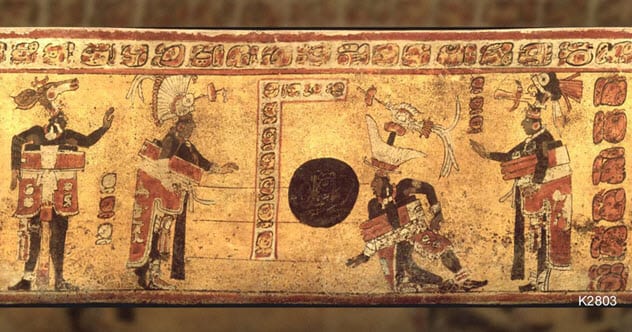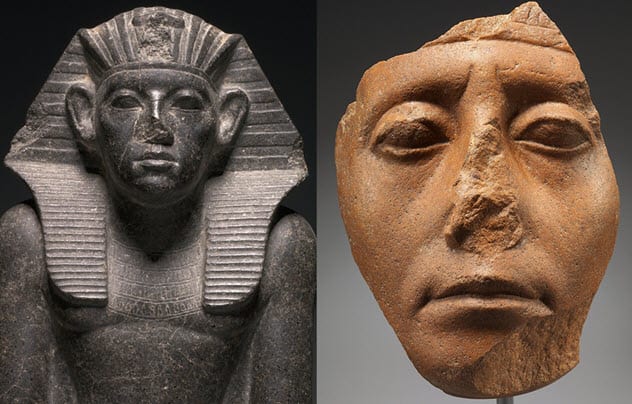 Technology
Technology  Technology
Technology  Humans
Humans 10 Everyday Human Behaviors That Are Actually Survival Instincts
 Animals
Animals 10 Animals That Humiliated and Harmed Historical Leaders
 History
History 10 Most Influential Protests in Modern History
 Creepy
Creepy 10 More Representations of Death from Myth, Legend, and Folktale
 Technology
Technology 10 Scientific Breakthroughs of 2025 That’ll Change Everything
 Our World
Our World 10 Ways Icelandic Culture Makes Other Countries Look Boring
 Misconceptions
Misconceptions 10 Common Misconceptions About the Victorian Era
 Mysteries
Mysteries 10 Strange Unexplained Mysteries of 2025
 Miscellaneous
Miscellaneous 10 of History’s Most Bell-Ringing Finishing Moves
 Technology
Technology Top 10 Everyday Tech Buzzwords That Hide a Darker Past
 Humans
Humans 10 Everyday Human Behaviors That Are Actually Survival Instincts
 Animals
Animals 10 Animals That Humiliated and Harmed Historical Leaders
Who's Behind Listverse?

Jamie Frater
Head Editor
Jamie founded Listverse due to an insatiable desire to share fascinating, obscure, and bizarre facts. He has been a guest speaker on numerous national radio and television stations and is a five time published author.
More About Us History
History 10 Most Influential Protests in Modern History
 Creepy
Creepy 10 More Representations of Death from Myth, Legend, and Folktale
 Technology
Technology 10 Scientific Breakthroughs of 2025 That’ll Change Everything
 Our World
Our World 10 Ways Icelandic Culture Makes Other Countries Look Boring
 Misconceptions
Misconceptions 10 Common Misconceptions About the Victorian Era
 Mysteries
Mysteries 10 Strange Unexplained Mysteries of 2025
 Miscellaneous
Miscellaneous 10 of History’s Most Bell-Ringing Finishing Moves
10 Common Questions With Fascinating Explanations
Most of us wonder about things for which we never truly get answers. This is not because explanations are lacking but more because the questions are so common that they tend not to encourage a research binge. However, ordinary puzzles often have fascinating answers.
For example, there is a meaty secret behind the panda’s strict bamboo diet and a reason why mosquitoes ravish only certain people. Kids do have an advantage over adults when learning a new language, and although rain is odorless, there is a reason why humans can smell a storm even before the first drop falls.
10 Do Bulls Really Hate Red?

In 2007, the Discovery Channel tested this “fact” once and for all. The channel’s MythBusters decided to irritate a bull with three tests. During the first, the researchers planted three flags in the bull’s enclosure. There was only one red flag, and the animal charged it. However, the bull also ran with equal fury at a blue flag and a white flag.
The second test placed three dummies in the ring. Once again, they were respectively colored blue, red, and white. The bull charged all of them but attacked the white and blue dummies first.[1]
During the final experiment, he ignored a stationary red-clad man and chased after two people who ran around the ring wearing different colors. The truth is that cattle cannot see red. What angers a bull is movement.
In fact, the matador uses two capes during the fight. The bigger one is used for the majority of the show and is not even red. The small cape comes out near the end and is colored red for a gruesome reason—to hide the dying bull’s blood splatters.
9 Why Do Joints Crack?

Popping joints is a common thing. Doctors call the variety of cracks and creaks by the term “crepitus.” When joints separate, it causes gas bubbles in the fluid between the bones. This phenomenon received its first serious study in 1947. The conclusion that the noises followed the formation of bubbles triggered a heavy debate. Another group of scientists believed that the popping was the sound of bubbles bursting.
In 2015, real-time imaging settled the fight. It was bubble formation, not bursting, that causes crepitus. Joints can separate and invite gas bubbles for several reasons. This includes natural movements, deliberate actions on the person’s part, condition like hypermobility and osteoarthritis, and aging.[2]
Another question dogs this phenomenon. Does deliberately popping one’s fingers cause arthritis?
The answer is “no.” Several studies proved this, as did one bizarrely dedicated researcher. To find the answer, he cracked his knuckles for 60 years. He did this only with one hand. When his hands were scanned, neither showed symptoms of arthritis or any other joint diseases.
8 Why Do People Get Static Shocks?

Most people are familiar with static shocks. These pinprick horrors leap from doorknobs, from other metal objects, and from between the fingers of two people. In addition, winter seems to be “shock season,” with an increased chance to get electrocuted by one’s own car or, frankly, any metal object.
At the heart of this harmless sting is static electricity. This type of charge collects on surfaces like carpets. When a person walks across a carpeted room, he scoops it up. In fact, he picks up millions of extra electrons. When the person touches something conductive, the electrons discharge into the object with a shocking sensation.
Sometimes, the process happens in reverse. One’s body abandons electrons, and an object’s extra electrons will jump to the fingers. The problem escalates in winter due to the season’s dry air.
During summer, atmospheric moisture acts as a conductor. The water channels electrons off the body in bursts so small that they cannot be felt. As moisture is lower in winter, the electrons pile up instead of discharging as imperceptible bursts. Eventually, millions of electrons exist in a single painful zing.[3]
7 Why Do Some People Attract More Mosquitoes?

There is always that one sibling or friend who is a mosquito magnet. Even when other people are in the room with this individual, he attracts more bites. Scientists know that this is not an imaginary situation. Mosquitoes do seem to prefer some humans above others.
The insects’ feeding habits have been studied in detail, largely because they transmit serious diseases. Interestingly, it would appear that things like blood type or skin pigment—two popular guesses—have nothing to do with a mosquito’s choice. Rather, the critter is attracted to something that lives on human skin.
People are not just hosts to mosquitoes, they also provide the perfect environment for millions of fungi and bacteria. The mixture of species depends on the location from which the person lifted them—like the things we touch, eat and wear.[4]
Each micropopulation emits organic compounds, and once again, the scent varies based on the combination of the species. Mosquitoes find the odors of some combinations very attractive. What researchers still do not understand is why the pests prefer one specific smell over another.
6 Did The Maya Sacrifice Sport Losers?

The Maya and other cultures in Mesoamerica played the same ballgame. The ball was made of rubber, and the game was played by two teams in an I-shaped alley.
Most rules were gleaned from excavations, art, and historical records. The ball had to stay in the air as much as possible and could not be touched by anyone’s hands or feet. Points could be scored on each end of the “I” field or when the other team made a mistake. The game also had symbolic connections to the gods and cosmos.[5]
When the Spanish first attended a game in the 1500s, they were intrigued but soon decided to destroy the pastime. They found the game’s links to human sacrifice and idol worship unacceptable. This reason survived into modern times as did the belief that each game ended with the slaughter of a team, most often the losers.
One Mayan myth even described how a losing human team was decapitated by the winning team of gods. However, researchers believe that players were not sacrificed. Instead, what the Spanish witnessed was most likely captives being executed during a popular sports event.
5 Why Are The Noses Broken On Egyptian Statues?

Ancient Egypt is renowned for its artists. In particular, carvers produced statues in large numbers. The figures depicted pharaohs, elite individuals, animals, and gods.
Researchers and the public quickly noticed that many had a weird thing in common—their noses were missing. Either ancient Egyptians were abnormally clumsy or this was deliberate damage. It turned out to be statue murder.
Back in the day, a carving was not just a piece of inanimate art. It had a life force. A widely used ceremony enlisted specific oils and objects to give a statue life. This energy was believed to enter and exit through the nose, like breathing.
When the need arose to deactivate a statue’s life force, the nose was hacked off. Frankly, this was to smother the carving and kill it. The belief was widespread, and countless statues lost their nostrils. The leading reason was to stop the figures from harming looters, as many statues were protectors of temples and tombs.[6]
4 Why Can Nobody Feel The Earth Spin?

Here is a dizzying truth. At this moment, the Earth is rotating at about 1,675 kilometers per hour (1,040 mph) at the Equator. Yet nobody can feel this breakneck speed brought on by the planet’s rotation.
The reason is simple.
You and your surroundings are all moving at the same speed. It’s the same reason why passengers can comfortably walk inside a cabin while the plane is hurtling through the sky. Everything inside the plane—the people, furniture, and air—moves at the same pace.[7]
If the Earth suddenly stopped spinning or adopted another speed out of the blue, the aftermath would be disastrous. The epic braking would be felt by everyone in the worst way.
Not just because the world paused or slowed down too much. At this moment, the planet’s entire atmosphere is also moving at the same speed as everything else. However, if the Earth suddenly stopped, the atmosphere would continue to move at the same speed the planet was moving. The effect would be like a razor shaving everything off the surface of the planet.
3 Why Can We Smell Rain?

Rain does not have a scent. It is common knowledge that water is odorless as well as tasteless and colorless. However, shortly before raindrops start to fall, there is a distinct aroma. The earthy smell is fresh and almost uniformly described as pleasing. If rain is not the guilty party, then where do the delightful wafts come from?
In more scientific terms, this scent is called petrichor. It does not originate from the clouds or the air. Petrichor is a combination of plant oils and chemical compounds from microorganisms called actinobacteria. When the critters turn organic matter into chemicals, an alcohol called geosmin forms as a by-product.
Not only is geosmin the main component in petrichor, but the human nose is exquisitely sensitive to it. Right before a storm, humidity rises and turns the soil moister.
This energizes the actinobacteria, and geosmin levels spike. Petrichor compounds are released into the air when the first raindrops hit the ground. The drops turn petrichor into an aerosol, which can rapidly spread downwind and alert people of the coming rain.[8]
2 Why Do Pandas Eat Bamboo?

Bears are not supposed to be herbivores. Yet China’s giant panda lives almost exclusively on bamboo. Scientifically, the panda belongs to a group of carnivores called Carnivora. Even its protein-derived energy profile looks more like that of cats and wolves rather than that of herbivores.
A surprising discovery solved the question of this unusual bear. After months of tracking pandas in the wild, scientists found that the creatures ate mostly the protein-rich baby shoots. They even migrated to follow growing bamboo species as the seasons changed.
The surprise came when the team analyzed the bears’ poop. The bamboo had been processed by each panda’s gut as if it were meat. In fact, so much protein had been extracted that it matched the diets of hypercarnivores—animals that derive over 70 percent of their sustenance from prey. It would appear that pandas evolved to process these plants as “meat” in order to thrive in bamboo forests.[9]
1 Why Do Adults Struggle With Languages?

Few people miss this fact: Kids too young to tie their shoelaces pick up new languages like they pick up Lego bricks. Research has found that adults could be trying too hard.
During a study in 2014, native English speakers were asked to learn a fake language. The first group listened to words while coloring. The coloring distracted them from focusing exclusively on the language exercise. Their recall was compared with other groups that fully focused on learning the words, different categories of vocabulary, or the more complex category patterns that resemble grammar rules.
The last three groups did better with vocabulary, but the coloring group absorbed more advanced grammar. It would appear that kids are grammar masters because they use a memory system called procedural memory. This unconscious learning often happens in the background. For instance, it grasps bits and pieces of a new language while coloring.[10]
A second type called declarative memory develops later in life and is all about conscious learning. Adults tend to rely on the declarative system as students. While it helps with nearly everything else, it is not the best memory option for learning another language.
Read more answers to baffling questions on 10 Answers To Baffling Questions You’ve Always Wondered About and 10 Answers To Strange Questions About Life And Death.








